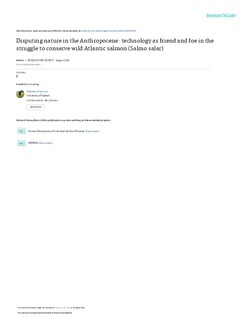Disputing nature in the Anthropocene: technology as friend and foe in the struggle to conserve wild Atlantic salmon (Salmo salar)
Peer reviewed, Journal article
Published version

Åpne
Permanent lenke
http://hdl.handle.net/11250/2609511Utgivelsesdato
2019Metadata
Vis full innførselSamlinger
- Scientific publications [1392]
Originalversjon
10.5751/ES-10945-240313Sammendrag
The Anthropocene, simply put, is characterized by the recognition that natural processes are inextricably entwined With human influence. Against this backdrop, managing natural resources needs to be fundamentally rethought as balancing human-nature entanglements continues to challenges policymakers and conservation managers obligated toward politically and scientifically feasible measures. A closer look at wild Atlantic salmon management in Europe reveals dynamic shifts over the past two centuries, particularly with regard to how hatcheries are used as conservation tools. We use case studies on Norwegian and Welsh wild salmon cultivation practices to trace these shifts in conservation and management practices. We frame our analysis through a lens of shifting conceptualizations of naturalness and human-salmon relationships. Starting at the multinational level and then moving to groundlevel cases, we show how naturalness is conceptualized by managers and hatchery stakeholders, and how those perceptions play into definitions of desired outcomes for wild salmon conservation as well as the strategies and technologies implemented to achieve these conservation goals. We highlight two paradoxes that are illuminated by the disputes and shifting perceptions surrounding salmon hatcheries. First, we show that hatcheries are no longer perceived as appropriate tools to increase wild salmon populations. Rather, hatchery technologies are being withdrawn, limited, or transformed, often resulting in local-level controversy. Paradoxically, these changes are, in themselves highly technical processes involving genomic testing and big data inventories. Second, despite the recognition of ever more complex human-nature entanglements, the practical outcomes for salmon conservation are oriented toward standardized testability and manageability and limiting certain human-salmon interactions, and although some technologies are instrumental, others are disregarded. As a result, those techno-social communities organized around hatchery technologies are at risk of being removed or otherwise excluded from their preferred conservation activities.